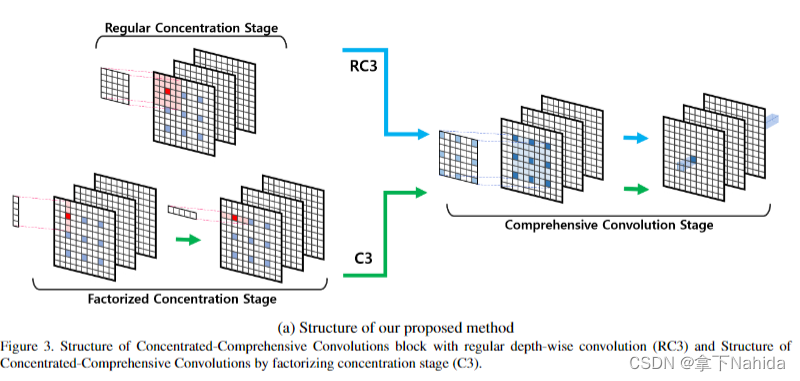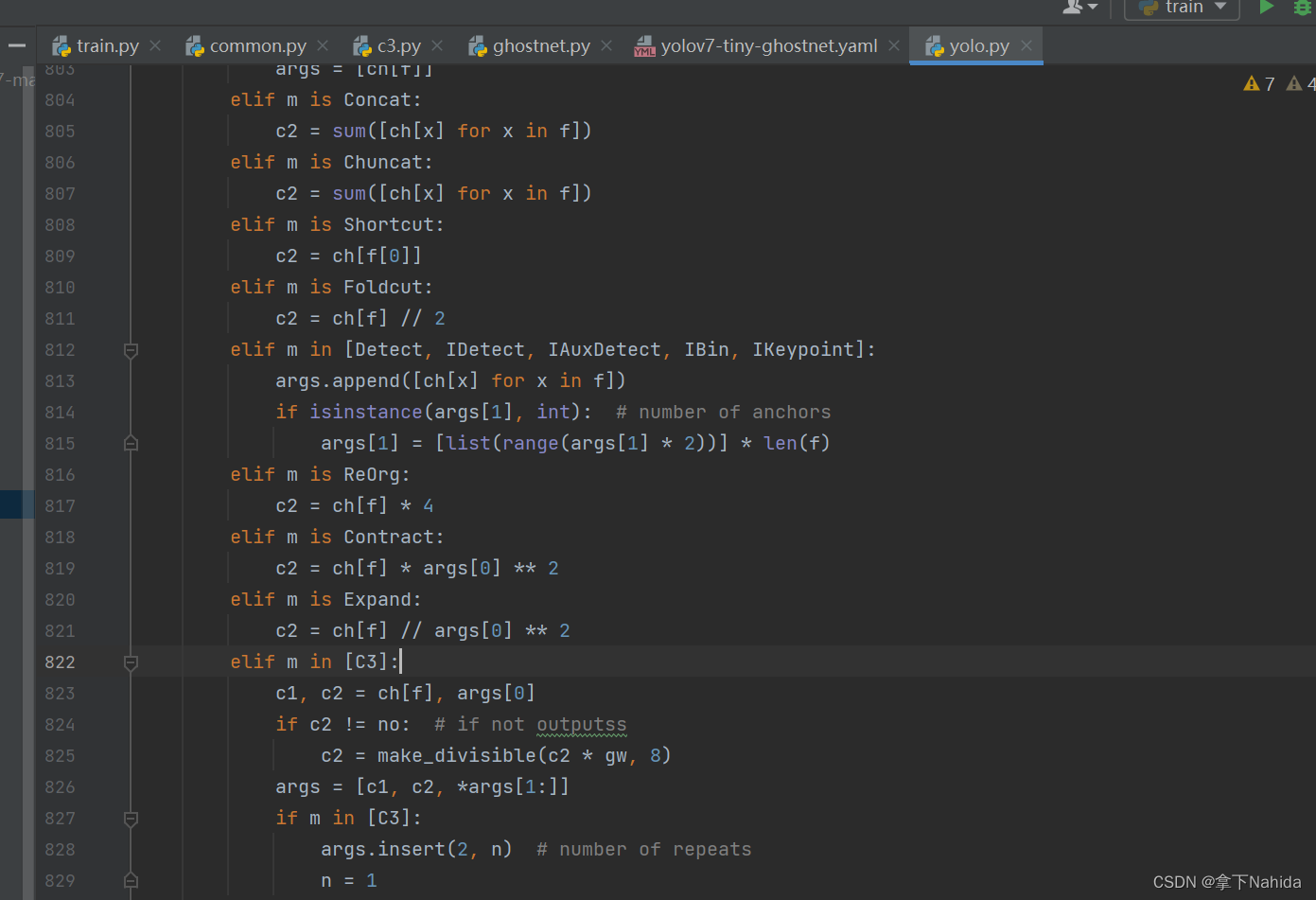
一、问题描述
在对YOLOv7做改进的时候,常常会遇到类似NameError: name 'C3' is not defined的报错,这是因为YOLOv7的common中没有加入C3模块。为此,运用本文可以添加C3模块。
二、C3模块导言
介绍了一种名为“集中-全面卷积”(Concentrated-Comprehensive Convolution,C3)的新模块,旨在创建轻量级的语义分割模型,同时保持高性能。C3模块通过解决将深度可分离卷积与膨胀卷积相结合时导致的信息损失问题,提高了模型效率。以下是C3模块及其应用的主要优点:
-
信息补偿机制:C3模块采用两阶段设计,首先使用深度方向的非对称卷积来收集并压缩相邻像素的信息,减轻由于膨胀卷积造成的局部信息丢失问题。这有助于提高模型的局部一致性。
-
计算效率提升:通过使用两个非对称卷积代替常规的深度卷积,特别是在高膨胀率下,显著降低了计算复杂度。对于N×N的核,分离卷积将每像素的计算复杂度从O(N^2)降低到2O(N),有助于在嵌入式系统中实现高效运行。
-
感受野扩展:C3模块的第二阶段使用深度可分离的膨胀卷积,扩大了感受野,增强了全局一致性。之后通过1×1的逐点卷积进行跨通道操作,进一步整合信息,构建出适合分割任务的宽广感受野。
-
轻量化与高性能并存:实验结果显示,C3模块在保持Cityscapes数据集上原有准确度的同时,减少了模型的复杂度。对ESPNet模型的修改案例中,C3模块使得参数量减半,FLOPs降低35%,且性能提升约2%。
-
广泛适用性验证:C3模块被成功应用于多种分割框架(ESPNet、DRN、ERFNet、ENet),证明了其作为一种即插即用模块的灵活性和普遍适用性。
-
分类任务的拓展应用:除了语义分割,C3模块还被应用于ImageNet分类任务,展示出替换膨胀卷积并维持或提升性能的能力,进一步验证了其作为深度学习基本构建块的潜力。
总之,C3模块通过创新的结构设计,有效融合了深度可分离卷积和膨胀卷积的优点,实现了轻量化模型设计中的一个关键突破,同时保持了分割和分类任务的高性能表现。

三、C3代码描述
作用: C3 类设计用于提升模型的特征表达能力同时维持或减少计算成本,通过结合输入特征的两种不同路径处理结果,适合于各种视觉任务,尤其是对模型效率和性能有高要求的应用场景,如目标检测、图像识别等。
特点:
-
三卷积结构: 与名称相符,此模块包含三个主要的卷积操作 (
cv1,cv2,cv3)。前两个用于分别独立处理输入特征,第三个用于合并前两个路径的输出。 -
特征分叉处理: 输入首先被分为两路,一路(
cv1后的特征)通过一个序列化的Bottleneck结构(self.m)进行深层次特征提取,另一路(cv2)则直接通过1x1卷积进行简单的通道调整但保留原始空间信息。这种方式允许模型同时考虑深度特征表达和保持对原始输入特征的直接传递。 -
CSP设计理念: 通过
torch.cat操作将两条路径的输出在通道维度上拼接,既融合了深层特征也保留了浅层特征,实现了跨阶段的部分特征重用,有助于提高模型的泛化能力和效率。 -
灵活性: 通过参数
n(Bottleneck块的数量)、shortcut(是否使用捷径连接)、g(组卷积的组数)和e(通道扩展比例),提供了高度的自定义能力,可以根据具体任务需求调整模型的复杂度和性能。
总结: C3 类通过引入三卷积结构和改进的特征处理流程,进一步优化了CSPNet架构的设计思路,旨在平衡计算效率与模型表现。这种方法在处理复杂视觉任务时特别有用,既能深入挖掘特征细节,又能有效利用计算资源,是现代高效神经网络设计中的一个重要组件。
四、准备工作
首先在YOLOv7项目文件下的models文件夹下创建新的文件c3.py
导入如下代码
from models.common import *
class C3(nn.Module):
# CSP Bottleneck with 3 convolutions
def __init__(self, c1, c2, n=1, shortcut=True, g=1, e=0.5): # ch_in, ch_out, number, shortcut, groups, expansion
super().__init__()
c_ = int(c2 * e) # hidden channels
self.cv1 = Conv(c1, c_, 1, 1)
self.cv2 = Conv(c1, c_, 1, 1)
self.cv3 = Conv(2 * c_, c2, 1) # act=FReLU(c2)
self.m = nn.Sequential(*(Bottleneck(c_, c_, shortcut, g, e=1.0) for _ in range(n)))
def forward(self, x):
return self.cv3(torch.cat((self.m(self.cv1(x)), self.cv2(x)), dim=1))
其次在在YOLOv7项目文件下的models/yolo.py中在文件首部添加代码
from models.c3 import *并搜索def parse_model(d, ch)
定位到如下行添加以下代码

elif m in [C3]:
c1, c2 = ch[f], args[0]
if c2 != no: # if not outputss
c2 = make_divisible(c2 * gw, 8)
args = [c1, c2, *args[1:]]
if m in [C3]:
args.insert(2, n) # number of repeats
n = 1
三、YOLOv7-tiny改进工作
完成二后,在YOLOv5项目文件下的models文件夹下创建新的文件yolov7-tiny-c3.yaml,导入如下代码。
# parameters
nc: 80 # number of classes
depth_multiple: 1.0 # model depth multiple
width_multiple: 1.0 # layer channel multiple
# anchors
anchors:
- [10,13, 16,30, 33,23] # P3/8
- [30,61, 62,45, 59,119] # P4/16
- [116,90, 156,198, 373,326] # P5/32
# yolov7-tiny backbone
backbone:
# [from, number, module, args] c2, k=1, s=1, p=None, g=1, act=True
[[-1, 1, Conv, [32, 3, 2, None, 1, nn.LeakyReLU(0.1)]], # 0-P1/2
[-1, 1, Conv, [64, 3, 2, None, 1, nn.LeakyReLU(0.1)]], # 1-P2/4
[-1, 1, Conv, [32, 1, 1, None, 1, nn.LeakyReLU(0.1)]],
[-2, 1, Conv, [32, 1, 1, None, 1, nn.LeakyReLU(0.1)]],
[-1, 1, Conv, [32, 3, 1, None, 1, nn.LeakyReLU(0.1)]],
[-1, 1, Conv, [32, 3, 1, None, 1, nn.LeakyReLU(0.1)]],
[[-1, -2, -3, -4], 1, Concat, [1]],
[-1, 1, Conv, [64, 1, 1, None, 1, nn.LeakyReLU(0.1)]], # 7
[-1, 1, MP, []], # 8-P3/8
[-1, 1, Conv, [64, 1, 1, None, 1, nn.LeakyReLU(0.1)]],
[-2, 1, Conv, [64, 1, 1, None, 1, nn.LeakyReLU(0.1)]],
[-1, 1, Conv, [64, 3, 1, None, 1, nn.LeakyReLU(0.1)]],
[-1, 1, Conv, [64, 3, 1, None, 1, nn.LeakyReLU(0.1)]],
[[-1, -2, -3, -4], 1, Concat, [1]],
[-1, 1, Conv, [128, 1, 1, None, 1, nn.LeakyReLU(0.1)]], # 14
[-1, 1, MP, []], # 15-P4/16
[-1, 1, Conv, [128, 1, 1, None, 1, nn.LeakyReLU(0.1)]],
[-2, 1, Conv, [128, 1, 1, None, 1, nn.LeakyReLU(0.1)]],
[-1, 1, Conv, [128, 3, 1, None, 1, nn.LeakyReLU(0.1)]],
[-1, 1, Conv, [128, 3, 1, None, 1, nn.LeakyReLU(0.1)]],
[[-1, -2, -3, -4], 1, Concat, [1]],
[-1, 1, Conv, [256, 1, 1, None, 1, nn.LeakyReLU(0.1)]], # 21
[-1, 1, MP, []], # 22-P5/32
[-1, 1, Conv, [256, 1, 1, None, 1, nn.LeakyReLU(0.1)]],
[-2, 1, Conv, [256, 1, 1, None, 1, nn.LeakyReLU(0.1)]],
[-1, 1, Conv, [256, 3, 1, None, 1, nn.LeakyReLU(0.1)]],
[-1, 1, Conv, [256, 3, 1, None, 1, nn.LeakyReLU(0.1)]],
[[-1, -2, -3, -4], 1, Concat, [1]],
[-1, 1, Conv, [512, 1, 1, None, 1, nn.LeakyReLU(0.1)]], # 28
]
# yolov7-tiny head
head:
[[-1, 1, Conv, [256, 1, 1, None, 1, nn.LeakyReLU(0.1)]],
[-2, 1, Conv, [256, 1, 1, None, 1, nn.LeakyReLU(0.1)]],
[-1, 1, SP, [5]],
[-2, 1, SP, [9]],
[-3, 1, SP, [13]],
[[-1, -2, -3, -4], 1, Concat, [1]],
[-1, 1, Conv, [256, 1, 1, None, 1, nn.LeakyReLU(0.1)]],
[[-1, -7], 1, Concat, [1]],
[-1, 1, Conv, [256, 1, 1, None, 1, nn.LeakyReLU(0.1)]], # 37
[-1, 1, Conv, [128, 1, 1, None, 1, nn.LeakyReLU(0.1)]],
[-1, 1, nn.Upsample, [None, 2, 'nearest']],
[21, 1, Conv, [128, 1, 1, None, 1, nn.LeakyReLU(0.1)]], # route backbone P4
[[-1, -2], 1, Concat, [1]],
[-1, 1, Conv, [64, 1, 1, None, 1, nn.LeakyReLU(0.1)]],
[-2, 1, Conv, [64, 1, 1, None, 1, nn.LeakyReLU(0.1)]],
[-1, 1, Conv, [64, 3, 1, None, 1, nn.LeakyReLU(0.1)]],
[-1, 1, Conv, [64, 3, 1, None, 1, nn.LeakyReLU(0.1)]],
[[-1, -2, -3, -4], 1, Concat, [1]],
[-1, 1, Conv, [128, 1, 1, None, 1, nn.LeakyReLU(0.1)]], # 47
[-1, 1, Conv, [64, 1, 1, None, 1, nn.LeakyReLU(0.1)]],
[-1, 1, nn.Upsample, [None, 2, 'nearest']],
[14, 1, Conv, [64, 1, 1, None, 1, nn.LeakyReLU(0.1)]], # route backbone P3
[[-1, -2], 1, Concat, [1]],
[-1, 1, Conv, [32, 1, 1, None, 1, nn.LeakyReLU(0.1)]],
[-2, 1, Conv, [32, 1, 1, None, 1, nn.LeakyReLU(0.1)]],
[-1, 1, Conv, [32, 3, 1, None, 1, nn.LeakyReLU(0.1)]],
[-1, 1, Conv, [32, 3, 1, None, 1, nn.LeakyReLU(0.1)]],
[[-1, -2, -3, -4], 1, Concat, [1]],
[-1, 1, Conv, [64, 1, 1, None, 1, nn.LeakyReLU(0.1)]], # 57
[-1, 1, Conv, [128, 3, 2, None, 1, nn.LeakyReLU(0.1)]],
[[-1, 47], 1, Concat, [1]],
[-1, 1, Conv, [64, 1, 1, None, 1, nn.LeakyReLU(0.1)]],
[-2, 1, Conv, [64, 1, 1, None, 1, nn.LeakyReLU(0.1)]],
[-1, 1, Conv, [64, 3, 1, None, 1, nn.LeakyReLU(0.1)]],
[-1, 1, Conv, [64, 3, 1, None, 1, nn.LeakyReLU(0.1)]],
[[-1, -2, -3, -4], 1, Concat, [1]],
[-1, 1, Conv, [128, 1, 1, None, 1, nn.LeakyReLU(0.1)]], # 65
[-1, 1, Conv, [256, 3, 2, None, 1, nn.LeakyReLU(0.1)]],
[[-1, 37], 1, Concat, [1]],
[-1, 1, Conv, [128, 1, 1, None, 1, nn.LeakyReLU(0.1)]],
[-2, 1, Conv, [128, 1, 1, None, 1, nn.LeakyReLU(0.1)]],
[-1, 1, Conv, [128, 3, 1, None, 1, nn.LeakyReLU(0.1)]],
[-1, 1, Conv, [128, 3, 1, None, 1, nn.LeakyReLU(0.1)]],
[[-1, -2, -3, -4], 1, Concat, [1]],
[-1, 1, C3, [256, 1, 1]], # 73
[57, 1, Conv, [128, 3, 1, None, 1, nn.LeakyReLU(0.1)]],
[65, 1, Conv, [256, 3, 1, None, 1, nn.LeakyReLU(0.1)]],
[73, 1, Conv, [512, 3, 1, None, 1, nn.LeakyReLU(0.1)]],
[[74,75,76], 1, IDetect, [nc, anchors]], # Detect(P3, P4, P5)
]
from n params module arguments
0 -1 1 928 models.common.Conv [3, 32, 3, 2, None, 1, LeakyReLU(negative_slope=0.1)]
1 -1 1 18560 models.common.Conv [32, 64, 3, 2, None, 1, LeakyReLU(negative_slope=0.1)]
2 -1 1 2112 models.common.Conv [64, 32, 1, 1, None, 1, LeakyReLU(negative_slope=0.1)]
3 -2 1 2112 models.common.Conv [64, 32, 1, 1, None, 1, LeakyReLU(negative_slope=0.1)]
4 -1 1 9280 models.common.Conv [32, 32, 3, 1, None, 1, LeakyReLU(negative_slope=0.1)]
5 -1 1 9280 models.common.Conv [32, 32, 3, 1, None, 1, LeakyReLU(negative_slope=0.1)]
6 [-1, -2, -3, -4] 1 0 models.common.Concat [1]
7 -1 1 8320 models.common.Conv [128, 64, 1, 1, None, 1, LeakyReLU(negative_slope=0.1)]
8 -1 1 0 models.common.MP []
9 -1 1 4224 models.common.Conv [64, 64, 1, 1, None, 1, LeakyReLU(negative_slope=0.1)]
10 -2 1 4224 models.common.Conv [64, 64, 1, 1, None, 1, LeakyReLU(negative_slope=0.1)]
11 -1 1 36992 models.common.Conv [64, 64, 3, 1, None, 1, LeakyReLU(negative_slope=0.1)]
12 -1 1 36992 models.common.Conv [64, 64, 3, 1, None, 1, LeakyReLU(negative_slope=0.1)]
13 [-1, -2, -3, -4] 1 0 models.common.Concat [1]
14 -1 1 33024 models.common.Conv [256, 128, 1, 1, None, 1, LeakyReLU(negative_slope=0.1)]
15 -1 1 0 models.common.MP []
16 -1 1 16640 models.common.Conv [128, 128, 1, 1, None, 1, LeakyReLU(negative_slope=0.1)]
17 -2 1 16640 models.common.Conv [128, 128, 1, 1, None, 1, LeakyReLU(negative_slope=0.1)]
18 -1 1 147712 models.common.Conv [128, 128, 3, 1, None, 1, LeakyReLU(negative_slope=0.1)]
19 -1 1 147712 models.common.Conv [128, 128, 3, 1, None, 1, LeakyReLU(negative_slope=0.1)]
20 [-1, -2, -3, -4] 1 0 models.common.Concat [1]
21 -1 1 131584 models.common.Conv [512, 256, 1, 1, None, 1, LeakyReLU(negative_slope=0.1)]
22 -1 1 0 models.common.MP []
23 -1 1 66048 models.common.Conv [256, 256, 1, 1, None, 1, LeakyReLU(negative_slope=0.1)]
24 -2 1 66048 models.common.Conv [256, 256, 1, 1, None, 1, LeakyReLU(negative_slope=0.1)]
25 -1 1 590336 models.common.Conv [256, 256, 3, 1, None, 1, LeakyReLU(negative_slope=0.1)]
26 -1 1 590336 models.common.Conv [256, 256, 3, 1, None, 1, LeakyReLU(negative_slope=0.1)]
27 [-1, -2, -3, -4] 1 0 models.common.Concat [1]
28 -1 1 525312 models.common.Conv [1024, 512, 1, 1, None, 1, LeakyReLU(negative_slope=0.1)]
29 -1 1 131584 models.common.Conv [512, 256, 1, 1, None, 1, LeakyReLU(negative_slope=0.1)]
30 -2 1 131584 models.common.Conv [512, 256, 1, 1, None, 1, LeakyReLU(negative_slope=0.1)]
31 -1 1 0 models.common.SP [5]
32 -2 1 0 models.common.SP [9]
33 -3 1 0 models.common.SP [13]
34 [-1, -2, -3, -4] 1 0 models.common.Concat [1]
35 -1 1 262656 models.common.Conv [1024, 256, 1, 1, None, 1, LeakyReLU(negative_slope=0.1)]
36 [-1, -7] 1 0 models.common.Concat [1]
37 -1 1 131584 models.common.Conv [512, 256, 1, 1, None, 1, LeakyReLU(negative_slope=0.1)]
38 -1 1 33024 models.common.Conv [256, 128, 1, 1, None, 1, LeakyReLU(negative_slope=0.1)]
39 -1 1 0 torch.nn.modules.upsampling.Upsample [None, 2, 'nearest']
40 21 1 33024 models.common.Conv [256, 128, 1, 1, None, 1, LeakyReLU(negative_slope=0.1)]
41 [-1, -2] 1 0 models.common.Concat [1]
42 -1 1 16512 models.common.Conv [256, 64, 1, 1, None, 1, LeakyReLU(negative_slope=0.1)]
43 -2 1 16512 models.common.Conv [256, 64, 1, 1, None, 1, LeakyReLU(negative_slope=0.1)]
44 -1 1 36992 models.common.Conv [64, 64, 3, 1, None, 1, LeakyReLU(negative_slope=0.1)]
45 -1 1 36992 models.common.Conv [64, 64, 3, 1, None, 1, LeakyReLU(negative_slope=0.1)]
46 [-1, -2, -3, -4] 1 0 models.common.Concat [1]
47 -1 1 33024 models.common.Conv [256, 128, 1, 1, None, 1, LeakyReLU(negative_slope=0.1)]
48 -1 1 8320 models.common.Conv [128, 64, 1, 1, None, 1, LeakyReLU(negative_slope=0.1)]
49 -1 1 0 torch.nn.modules.upsampling.Upsample [None, 2, 'nearest']
50 14 1 8320 models.common.Conv [128, 64, 1, 1, None, 1, LeakyReLU(negative_slope=0.1)]
51 [-1, -2] 1 0 models.common.Concat [1]
52 -1 1 4160 models.common.Conv [128, 32, 1, 1, None, 1, LeakyReLU(negative_slope=0.1)]
53 -2 1 4160 models.common.Conv [128, 32, 1, 1, None, 1, LeakyReLU(negative_slope=0.1)]
54 -1 1 9280 models.common.Conv [32, 32, 3, 1, None, 1, LeakyReLU(negative_slope=0.1)]
55 -1 1 9280 models.common.Conv [32, 32, 3, 1, None, 1, LeakyReLU(negative_slope=0.1)]
56 [-1, -2, -3, -4] 1 0 models.common.Concat [1]
57 -1 1 8320 models.common.Conv [128, 64, 1, 1, None, 1, LeakyReLU(negative_slope=0.1)]
58 -1 1 73984 models.common.Conv [64, 128, 3, 2, None, 1, LeakyReLU(negative_slope=0.1)]
59 [-1, 47] 1 0 models.common.Concat [1]
60 -1 1 16512 models.common.Conv [256, 64, 1, 1, None, 1, LeakyReLU(negative_slope=0.1)]
61 -2 1 16512 models.common.Conv [256, 64, 1, 1, None, 1, LeakyReLU(negative_slope=0.1)]
62 -1 1 36992 models.common.Conv [64, 64, 3, 1, None, 1, LeakyReLU(negative_slope=0.1)]
63 -1 1 36992 models.common.Conv [64, 64, 3, 1, None, 1, LeakyReLU(negative_slope=0.1)]
64 [-1, -2, -3, -4] 1 0 models.common.Concat [1]
65 -1 1 33024 models.common.Conv [256, 128, 1, 1, None, 1, LeakyReLU(negative_slope=0.1)]
66 -1 1 295424 models.common.Conv [128, 256, 3, 2, None, 1, LeakyReLU(negative_slope=0.1)]
67 [-1, 37] 1 0 models.common.Concat [1]
68 -1 1 65792 models.common.Conv [512, 128, 1, 1, None, 1, LeakyReLU(negative_slope=0.1)]
69 -2 1 65792 models.common.Conv [512, 128, 1, 1, None, 1, LeakyReLU(negative_slope=0.1)]
70 -1 1 147712 models.common.Conv [128, 128, 3, 1, None, 1, LeakyReLU(negative_slope=0.1)]
71 -1 1 147712 models.common.Conv [128, 128, 3, 1, None, 1, LeakyReLU(negative_slope=0.1)]
72 [-1, -2, -3, -4] 1 0 models.common.Concat [1]
73 -1 1 361984 models.c3.C3 [512, 256, 1, 1, 1]
74 57 1 73984 models.common.Conv [64, 128, 3, 1, None, 1, LeakyReLU(negative_slope=0.1)]
75 65 1 295424 models.common.Conv [128, 256, 3, 1, None, 1, LeakyReLU(negative_slope=0.1)]
76 73 1 1180672 models.common.Conv [256, 512, 3, 1, None, 1, LeakyReLU(negative_slope=0.1)]
77 [74, 75, 76] 1 17132 models.yolo.IDetect [1, [[10, 13, 16, 30, 33, 23], [30, 61, 62, 45, 59, 119], [116, 90, 156, 198, 373, 326]], [128, 256, 512]]
Model Summary: 282 layers, 6245388 parameters, 6245388 gradients, 13.4 GFLOPS运行后若打印出如上文本代表改进成功。
除此之外,还可以将c3模块放在多个位置,本文仅是做一个参考。
更多文章产出中,主打简洁和准确,欢迎关注我,共同探讨!























 1377
1377

 被折叠的 条评论
为什么被折叠?
被折叠的 条评论
为什么被折叠?








